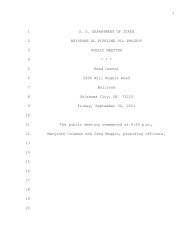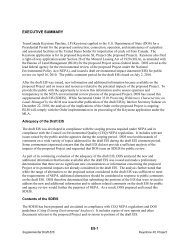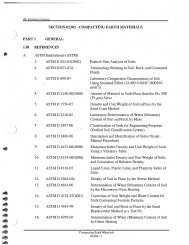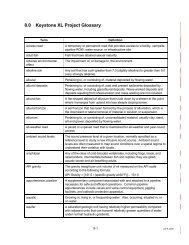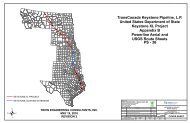2.1 Overview of the Proposed Project - Keystone XL pipeline - US ...
2.1 Overview of the Proposed Project - Keystone XL pipeline - US ...
2.1 Overview of the Proposed Project - Keystone XL pipeline - US ...
Create successful ePaper yourself
Turn your PDF publications into a flip-book with our unique Google optimized e-Paper software.
Draft Supplemental Environmental Impact Statement<strong>Keystone</strong> <strong>XL</strong> <strong>Project</strong>trench, and restoring <strong>the</strong> ROW. In areas where <strong>the</strong>re is no reasonable access to <strong>the</strong> ROW exceptthrough wetlands, non-essential equipment would be allowed to travel through wetlands only if<strong>the</strong> ground is firm enough or has been stabilized with approved pre-fabricated matting (nottimber slash) to avoid rutting. Where wetland soils are supersaturated or inundated, <strong>the</strong> <strong>pipeline</strong>could be installed using <strong>the</strong> push-pull technique. The push-pull installation process wouldinvolve stringing and welding <strong>the</strong> <strong>pipeline</strong> outside <strong>of</strong> <strong>the</strong> wetland, and excavating and backfilling<strong>the</strong> trench using a backhoe supported by equipment mats or timber riprap. Constructionequipment working in all wetlands would be limited to that area essential for clearing <strong>the</strong> ROW,excavating <strong>the</strong> trench, fabricating and installing <strong>the</strong> <strong>pipeline</strong>, backfilling <strong>the</strong> trench, and restoring<strong>the</strong> ROW. In areas where <strong>the</strong>re is no reasonable access to <strong>the</strong> ROW except through wetlands,non-essential equipment would be allowed to travel through wetlands only if <strong>the</strong> ground is firmenough or has been stabilized with approved pre-fabricated matting (not timber slash) to avoidrutting. The <strong>pipeline</strong> segment would be installed in <strong>the</strong> wetland by equipping it with floats andpushing or pulling it across <strong>the</strong> water-filled trench. After <strong>the</strong> <strong>pipeline</strong> is floated into place, <strong>the</strong>floats would be removed and <strong>the</strong> <strong>pipeline</strong> would sink into place. Most pipes installed in saturatedwetlands would be coated with concrete or installed with set-on weights to provide negativebuoyancy. The criteria used to determine pipe selection are based on site-specific conditions,ease <strong>of</strong> implementation, and practicality <strong>of</strong> implementing <strong>the</strong> installation method. The preferenceis set-on weights.Following installation <strong>of</strong> <strong>the</strong> <strong>pipeline</strong>, subsoils (clays and gravel/cobbles) would be backfilledfirst followed by <strong>the</strong> topsoil. Restoration <strong>of</strong> contours would be accomplished during backfilling.No grading would occur in wetlands and <strong>the</strong> soil surface would be roughed to enhance seedgermination. Soil strata would be restored above <strong>the</strong> <strong>pipeline</strong> to replicate original conditions.Topsoil would be replaced to <strong>the</strong> original ground level leaving no crown over <strong>the</strong> trench line.Excess excavated material would be removed from <strong>the</strong> wetland and spread along <strong>the</strong> uplandROW, placed in a location as requested by a landowner, or disposed <strong>of</strong> at an existing authorizedlandfill. Equipment mats, gravel fill, geotextile fabric, and straw mats would be removed fromwetlands after backfilling except in <strong>the</strong> travel lane to allow continued, controlled access through<strong>the</strong> wetland until <strong>the</strong> completion <strong>of</strong> construction. Once revegetation is successful, sedimentbarriers would be removed from <strong>the</strong> ROW and disposed <strong>of</strong> at an existing authorized landfill. Inwetlands where no standing water is present, <strong>the</strong> construction ROW would be seeded tosupplement regenerated growth from root stock from original excavation <strong>of</strong> soils, in accordancewith <strong>the</strong> recommendations <strong>of</strong> <strong>the</strong> <strong>US</strong>ACE, local soil conservation authorities, or landmanagement agency.<strong>2.1</strong>.9.3 Aboveground and Ancillary Facilities Construction ProceduresPump Station ConstructionConstruction at each new pump station and pigging facility would begin with installing sedimentcontrol measures, and <strong>the</strong>n <strong>the</strong> clearing <strong>of</strong> vegetation and removal <strong>of</strong> topsoil will take place Afterthat, <strong>the</strong> site would be graded as necessary to create a level working surface for <strong>the</strong> movement <strong>of</strong>construction vehicles and to prepare <strong>the</strong> area for building foundations. Each pump station wouldinclude one electrical equipment shelter (EES), and a variable frequency drive equipment shelter.The EES would include electrical systems, communication, and control equipment. Foundationswould be installed for <strong>the</strong> EES and <strong>the</strong> pump equipment shelter. The structures to support <strong>the</strong>pumps, manifolds, pig receiving and pig launching equipment, densitometers (where present),<strong>Project</strong> Description <strong>2.1</strong>-61 March 2013



